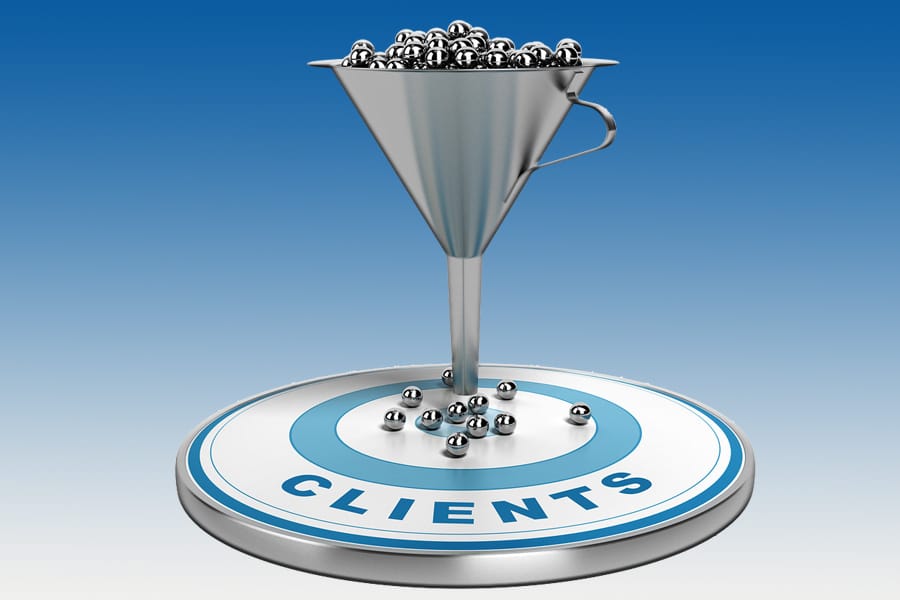There are all kinds of ways to describe a marketing sales funnel. The idea is that if you’re selling anything – your services or your products – you have to get lots of people in at the “top” of the funnel. Some of them (a smaller subset) will become leads that can be marketed to. Some of those leads (a smaller subset again) will become customers after they pay you money.
The set of people you’re working with is wide at the top, and narrower at the bottom when they pay you.
That’s easy enough to understand.
How to Build a Marketing Sales Funnel
There are many flavors of a marketing funnel, but at it’s simplest, there are three stages. How do you get people to the top of the funnel? You have a variety of options, including:
- Search engine optimization (SEO) of your website for what your ideal customers search for on Google
- Social media and blog posts
- Paid ads on social media or the search engines (like Google Adwords)
- Online press releases
This is called the “Awareness” stage. They’ve now become aware of you and your business because something drew them there or attracted them (“attraction marketing”).
But just because they visited your website, doesn’t mean much. I’m not particularly interested in traffic to my website. Visitors won’t pay my mortgage. So now we have to convert them to a lead. They have to give you their contact information in exchange for something of value to them. Your “lead magnet” is your “ethical bribe” that pries their information from them.
Typically this is an opt-in to download or view or get something that is valuable to them:
- Webinar
- Free report
- Access to a small training video
- A checklist
- Something else they can download and use (tools, spreadsheet, software, etc.)
Only a subset of those that come in the “top” of the funnel will be willing to give you their information, hence the funnel gets smaller in the middle.
By nurturing those leads with more useful information, you’ll get them to know, like and trust you more, which increases the odds that they’ll give you money. So some subset of the “leads” will get out their wallet and pay you for your products or services.
This smaller subset is the coveted reward at the bottom of the funnel. The more you put in the top, theoretically, the more drop out the bottom and convert.
I Have a Problem With This Funnel Model

Reality: Leaky Sales Marketing Funnel
If you look at the picture above, it looks like everyone who goes in the top eventually comes out the bottom as a paid client. This is so not true. Really, you have a leaky funnel, in which people are leaking out the sides before reaching the bottom. It’s a numbers game. You have to keep filling it up at the top in order to get a few out the bottom. It’s kind of like bailing a leaky boat, but in reverse.
If you stop filling it from the top, your sales dry up.
This is partially true, but it’s even more complicated than that. It’s easy to feel like if you’re not getting instant results out the bottom of the funnel, then your funnel is broken. Abandon that leaky boat, jump to the next shiny marketing thing that comes along and churn some more.
What you’ve probably forgotten is that the people in the middle don’t all leak out, but they don’t all convert to a sale right away either. Many of them are in the middle, sometimes for a long time, even a very long time. Not everyone is ready to whip out their wallet the minute you show them your cool stuff. If you abandon ship, you’re leaving money behind, and the possibility for a sale.
Just yesterday, I got a phone call from someone who went to one of my free workshops – 8 months ago. He was ready to move forward with a small, private, one-hour consultation that I had offered the class. I’ve even had people call me two years after doing a proposal, and that proposal had been sitting on their desk all that time.
A good friend of mine has said that she’s had people who were on her email list for years, and love her stuff. Sometimes they weren’t ready until years later to move forward. Then they became great clients because they already had a long-term – albeit virtual – relationship.
The Other Problem with the Funnel Model: Flip it Upside-Down!
It’s important to keep adding new people to your list. You’re going to lose a portion just to normal attrition: email addresses gone stale, changed jobs, and unsubscribes. So yes, you have to keep adding to it.
But don’t ever forget your current clients. They’re 80% more likely to buy from you again and become repeat customers, and it’s FAR easier to upsell or cross-sell to your current client list than convert a new one. By building a long-term relationship with your current client list (not just going for a one-time sale), they will refer you to their colleagues, thus expanding your funnel from narrow to wider.
So in short, you need two funnels:
- The “traditional” wide-to-narrow funnel
- The upside-down funnel from narrow-to-wide
Never abandon ship, because even though you’ve got a leaky funnel, just keep nurturing those leads over the long haul. They will pop out the bottom, but only when they’re ready to.
Keep widening your narrow, upside-down funnel by upsells and cross-sells to your existing client base. You’ve already worked hard to build the trust, so keep that door open.

